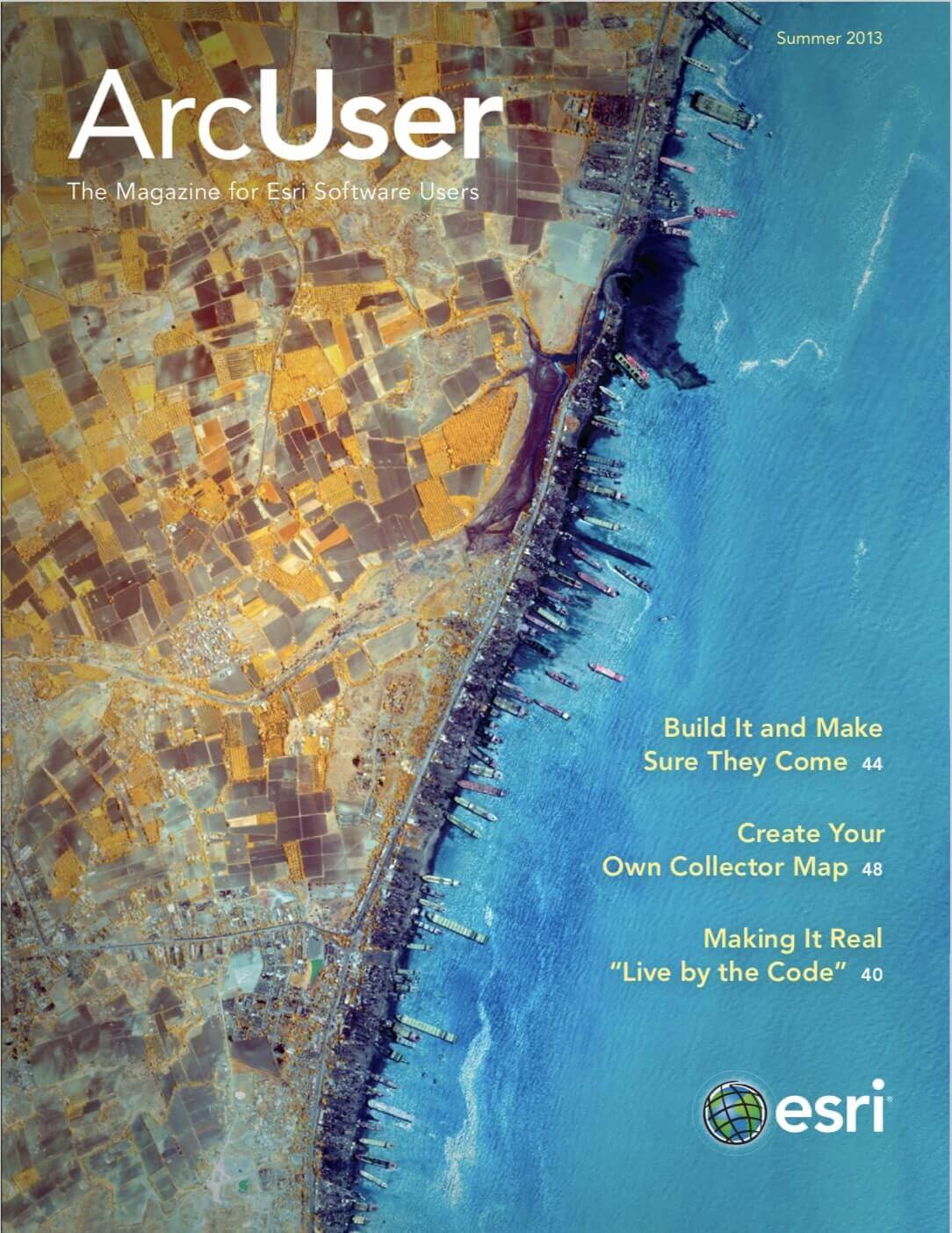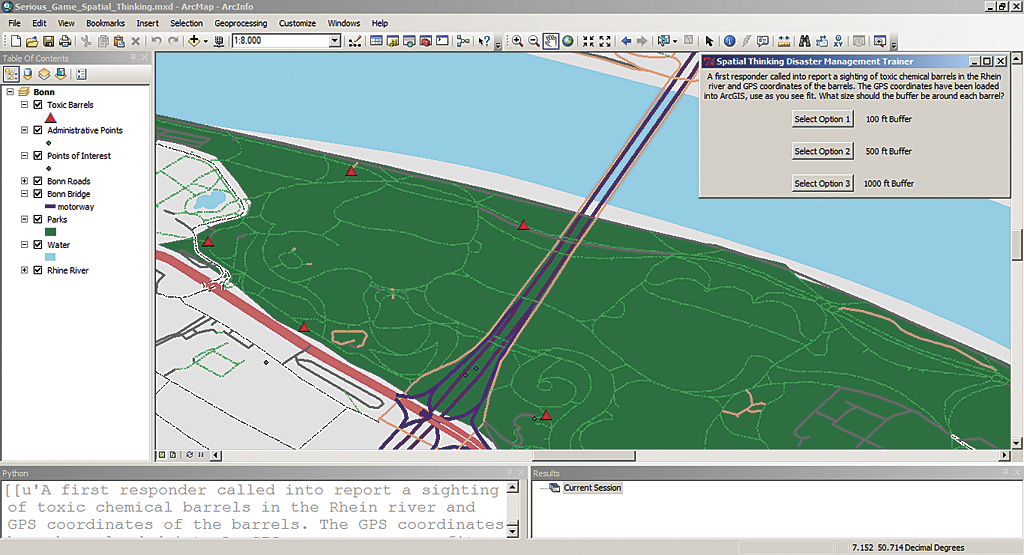
“Serious” games are games with a nonentertainment purpose. Spatial thinking is the idea of using the property’s space to structure and solve problems. It is critical to decision making in response to a disaster.
A team of student researchers at the Rochester Institute of Technology (RIT), working in partnership with the United Nations University Institute for Environment and Human Security (UNU-EHS) in Bonn, Germany, have developed a serious game in ArcGIS designed to measure the spatial thinking ability of disaster responders.
The game uses a disaster response scenario where toxic substances have washed up on the shore of the Rhine River in Bonn, Germany, after a flood. The game player is given a series of questions designed to measure spatial thinking abilities based on which ArcGIS tools they would use to respond to the disaster. Using real GIS data and tools in the game makes it particularly useful for realistic disaster management training. The following sections discuss the game in further detail and provide ideas for future work.
Using ArcGIS as a Serious Gaming Environment
The team developed the game’s graphic user interface (GUI) and functionality using the ArcPy Python library to handle the game’s interactions with ArcMap. The front-end system uses the Tkinter library [Python’s standard GUI package], which launches the gaming interface from the ArcMap Python window. When the game begins, it loads game questions specific to a given scenario, which are stored in JavaScript Object Notation (JSON) format. Because no two disasters are alike, a gaming framework was needed that could theoretically be expanded to work with any training scenario and keep all the data regarding the scenario separate from the gaming software itself. Thus, the JSON data format was an excellent choice for providing the flexibility needed to accommodate these factors.
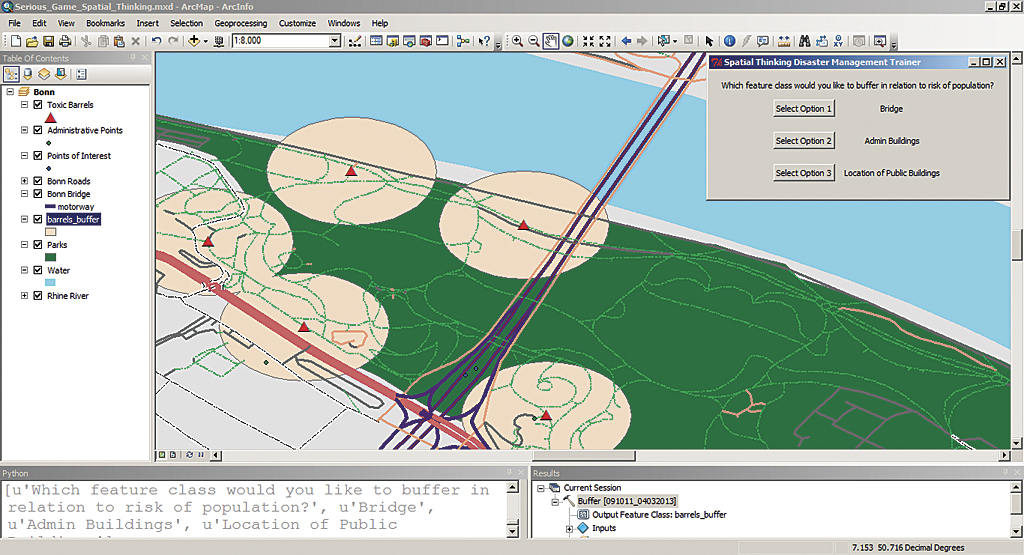
Upon starting the game, the user is presented with a representation of the affected area in ArcMap. The map includes features such as parks, roads, public buildings, general points of interest, as well as the location of the toxic barrels along the Rhine River. The scenario data for the game was obtained from OpenStreetMap, but any data that ArcMap can import can be used in the game.
Beginning with the first game question, the gaming interface displays information taken from the JSON file for the current scenario that provides from one to five possible choices for the game player to select. When the user selects one of the choices, the gaming interface repopulates with new information based on that choice. Also, if a particular GIS operation is required (say, creating a buffer around a bridge), the appropriate ArcMap tool or model is called using the ArcPy library. Results of the selected choice are then displayed in ArcMap.
By using this approach, game players do not focus on technical details of using various ArcMap tools. Instead, they focus on spatial thinking and decision-making tasks. Furthermore, this approach allows game players who are not familiar with the capabilities of GIS to see how a real GIS environment operates.
Spatial Thinking Abilities as a Score
The goal in developing the game was to measure spatial thinking. To do this, each decision the user makes is associated with a given score. For example, a user who chose the buffer tool to create multiple buffers around the chemical barrels would receive a lower score for that particular question, while a user who correctly selected the Multiple Ring Buffer tool would receive a higher score.
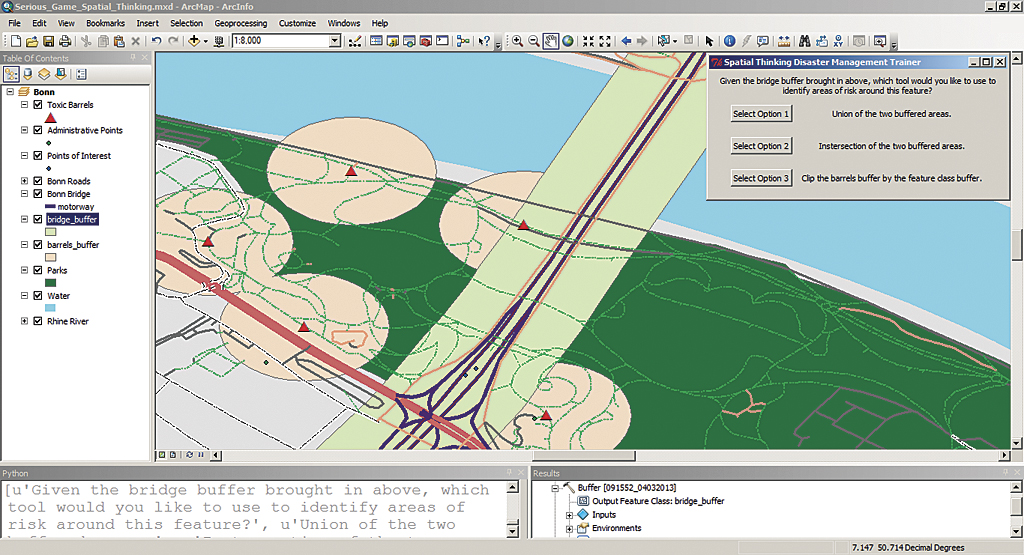
In addition, timing was incorporated into the game to simulate a sense of urgency to replicate the tense, stressful situations emergency responders face in real disaster response situations. Users who need more than the allotted time to make a decision receive a reduced score, even if they make the correct decision.
Upon completion of the game, the points for each question are added to present the user with an overall score that represents their grasp of the spatial thinking ability required in the game. The program also reports any discrepancies between the user’s selections and the ideal choices and discusses what the user could have done better and why another choice may have been the better option.
Conclusions and Future Work
ArcGIS compatibility with Python programming was essential in the development of a serious game aimed at measuring spatial thinking abilities using ArcGIS. Future work includes expanding the game for other types of disaster response scenarios and formal testing of the game with emergency management practitioners. Serious games like this one may find a place in testing the knowledge and abilities of emergency responders prior to disaster situations without incurring many of the costs associated with developing more realistic, hands-on scenarios. Furthermore, the game can be expanded beyond specific applications like emergency response to use as a general approach for teaching spatial thinking and GIS concepts.
For more information, contact
Brian Tomaszewski, PhD, Assistant Professor
Department of Information Sciences & Technologies
Rochester Institute of Technology
31 Lomb Memorial Drive
Rochester, New York 14623 USA
E-mail: bmtski@rit.edu
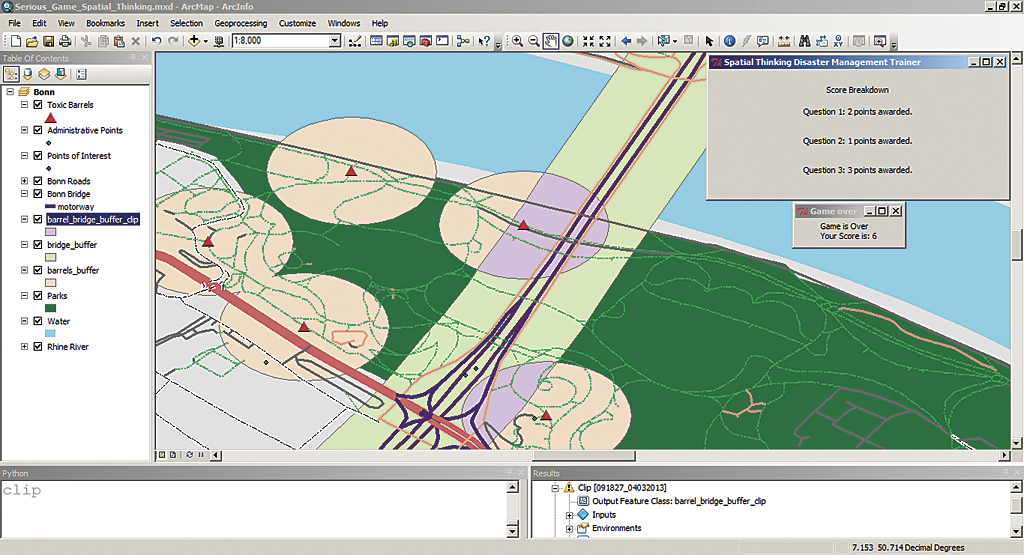
Acknowledgments
The work presented in this article was conducted in part by graduate students at the Rochester Institute of Technology funded through the National Science Foundation Science Master’s Program “Decision Support Technologies for Environmental Forecasting and Emergency Response” (NSF DGE-1011458).
About the Authors
Kevin Bloechl and Amanda Geniviva are students in the imaging science master’s program at the Rochester Institute of Technology.
Zachary Miller and Matthew Nadareski are students in the computer science master’s program at the Rochester Institute of Technology.
Alexa Dengos is a student in the environmental health and safety master’s program at the Rochester Institute of Technology.
Emily Feeney is a student in the professional studies master’s program at the Rochester Institute of Technology.
Alyssa Mathews is a student in the environmental science master’s program at the Rochester Institute of Technology.
Jonathan Nelson is a student in the science and technology master’s program at the Rochester Institute of Technology.
Jonathan Uihlein is a student in the information technology master’s program at the Rochester Institute of Technology.
Michael Floeser is a lecturer in the department of information sciences and technologies at the Rochester Institute of Technology.
Dr. Jörg Szarzynski is the head of the Enhancing Graduate Educational Capacities for Human Security Section (EGECHS) at the United Nations University Institute for Environment and Human Security (UNU-EHS) in Bonn, Germany.
Dr. Brian Tomaszewski is an assistant professor in the department of information sciences and technologies at the Rochester Institute of Technology.

